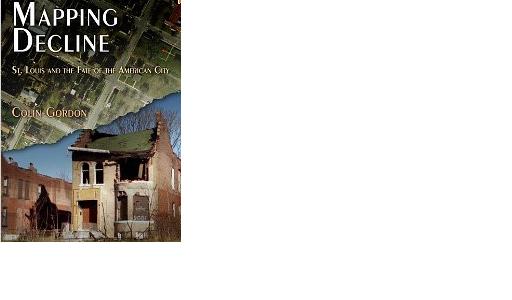 For the past couple of weeks, I’ve been providing highlights from Colin Gordon’s provocative study, Mapping Decline: St. Louis and the Fate of the American City (Penn Press, 2008). This week, I’ll continue recapping some of Gordon’s salient points, with a focus this time on what he terms “hypersegregation.”
For the past couple of weeks, I’ve been providing highlights from Colin Gordon’s provocative study, Mapping Decline: St. Louis and the Fate of the American City (Penn Press, 2008). This week, I’ll continue recapping some of Gordon’s salient points, with a focus this time on what he terms “hypersegregation.”
As with other phenomena related to urban decay, St Louis, says Gordon, “offers a particularly graphic and sustained version” of segregation: “the City’s racial demographics were starker and simpler than those of its peers.” “The national pattern of white flight and inner city decay,” Gordon quotes one observer as saying, “could be found in St. Louis ‘in somewhat purer and less ambiguous form than almost anywhere else.’”
Indeed, Gordon asserts, “St. Louis retained (decade after decade) its dubious distinction as one of the nation’s most segregated metropolitan areas.” In terms of its “segregation index,” “St. Louis ranked eighteenth of 237 MSAs [metropolitan areas] in 1960, fourteenth of 237 in 1970, and tenth of 318 in 1980.” In short, “St. Louis in 1980 ranked as one of a handful of ‘hypersegregated’ metro areas.”
So profound is the segregation between black and white, between City and County, that one observer has described the border between the City of St. Louis and St. Louis County as a kind of “Berlin Wall” between “city and county, the poor and the affluent, the black and the white.”
Such segregation didn’t just happen, according to Gordon. Rather, federal, state and local policies shaped residential patterns. Since I’m a former Professor of English (with a specialty in American ethnic literature), I immediately thought of Louise Hansberry’s 1959 play, A Raisin in the Sun, particularly as Gordon discusses real estate policies and practices designed to keep African Americans out of “white” neighborhoods.
Such policies and practices were based on “the conviction that African American occupancy was a blight to be contained, controlled, or eradicated.” “City planners (especially through the 1940s and 1950s),” says Gordon, “routinely equated black occupancy with ‘blight’ and watched its expansion north and west like the spread of a disease.”
The policies that shaped residential segregation “tilt[ed] the playing field dramatically in favor of those who were already winning” – so much so that it came to seem that “inner-city poverty” was “something African Americans had done to themselves.” “As a rapidly growing African American population crowded into hastily but strictly circumscribed blocks or neighborhoods,” Gordon says, “the immediate consequence was not only extreme stress on the housing stock but also an easy equation of overcrowding, crime, poor sanitation, and poor health with black occupancy itself.”
To get a stark visual of St. Louis’s hypersegregation, visit Gordon’s website and explore the numerous maps Gordon uses to illustrate the story of St. Louis’s decline. For example, click on “White Flight” – and then explore what happened in the years 1940-1950, 1950-1960, and all the way through to 1990-2000. The years 1970-1980 offer the most dramatic visual of white flight, with black and red sections of the map highlighting the intense racially-based residential patterns of the City and the County. The Documents page contains links to revealing primary sources, showing the policies that were used to segregate the City and its neighborhoods.
Next week, I’ll discuss Gordon’s analysis of what happened in the inner-ring suburbs, communities like Wellston that themselves felt the impact of abandonment, decay, and segregation.